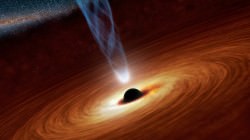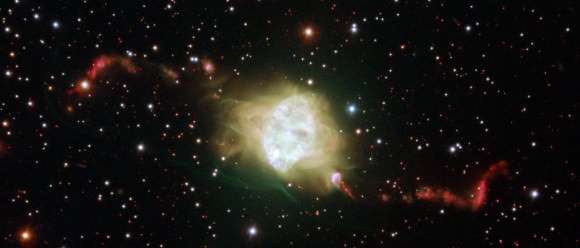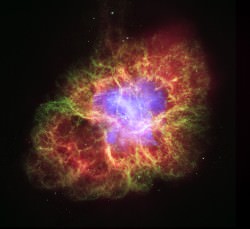Black holes are the most exotic and awe inspiring objects in the Universe.
Take the mass of an entire star. Compress it down into an object so compact that the force of gravity defies comprehension.
Nothing, not even light, can escape the pull of gravity from a black hole.
The idea was first conceived in the 18th century by the geologist John Mitchell. He realized that if you could compress the Sun down by several orders of magnitude, it would have gravity so strong that you’d need to be going faster than the speed of light to escape it.
Initially, black holes were considered nothing more than abstract mathematical concepts; even Einsten assumed they didn’t actually exist. But in 1931, the astronomer Chandrasekhar calculated that certain high mass stars might be able to collapse into black holes after all.
They turned out to be real, and over the next few decades, astronomers found many examples out in the Universe.
Stars are held in perfect balance by two opposing forces. There’s the inward pressure of gravity, attempting to collapse the star, counteracted by the outward pressure of the emitted radiation.

As the star consumes the last of its hydrogen, it switches to the stockpiles of helium that it has built up. After it runs out of helium, it switches to carbon, and then oxygen.
Since the star continues to pump out radiation, it balances out the gravitational forces trying to compress it.
 Stars with the mass of our Sun pretty much stop there. Not massive enough to continue the fusion reaction, beyond oxygen, they become a white dwarf and cool down.
Stars with the mass of our Sun pretty much stop there. Not massive enough to continue the fusion reaction, beyond oxygen, they become a white dwarf and cool down.
But for stars with about 5 times the mass of our Sun, the fusion process continues further up the periodic table to silicon, aluminum, potassium, and so on, all the way to iron.
No energy can be produced by fusing iron atoms together. It’s the stellar equivalent of ash.
 And so, in a fraction of a second, the radiation from the star turns off. Without that outward pressure from the radiation, gravity wins out and the star implodes. An entire star’s mass collapses down into a smaller and smaller volume of space.
And so, in a fraction of a second, the radiation from the star turns off. Without that outward pressure from the radiation, gravity wins out and the star implodes. An entire star’s mass collapses down into a smaller and smaller volume of space.
The velocity you would need to escape from the star goes up, until not even light is going fast enough to escape.
And this is how you form a black hole.
Well, that’s the main way.
You can also get black holes when dense objects, like neutron stars, collide with one another.
And then there are the supermassive black holes at the heart of every galaxy. And to be honest, astronomers still don’t know how those monsters formed.

